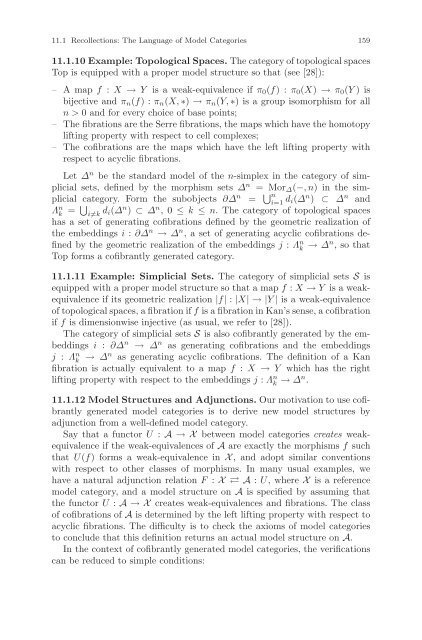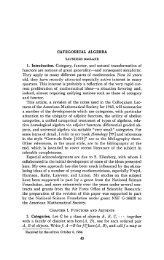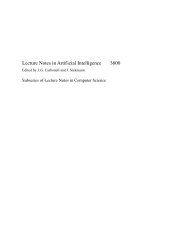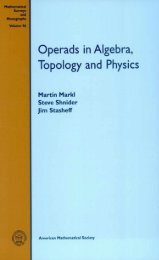Symmetric Monoidal Categories for Operads - Index of
Symmetric Monoidal Categories for Operads - Index of
Symmetric Monoidal Categories for Operads - Index of
You also want an ePaper? Increase the reach of your titles
YUMPU automatically turns print PDFs into web optimized ePapers that Google loves.
11.1 Recollections: The Language <strong>of</strong> Model <strong>Categories</strong> 159<br />
11.1.10 Example: Topological Spaces. The category <strong>of</strong> topological spaces<br />
Top is equipped with a proper model structure so that (see [28]):<br />
– A map f : X → Y is a weak-equivalence if π0(f) :π0(X) → π0(Y )is<br />
bijective and πn(f) :πn(X, ∗) → πn(Y,∗) is a group isomorphism <strong>for</strong> all<br />
n>0 and <strong>for</strong> every choice <strong>of</strong> base points;<br />
– The fibrations are the Serre fibrations, the maps which have the homotopy<br />
lifting property with respect to cell complexes;<br />
– The c<strong>of</strong>ibrations are the maps which have the left lifting property with<br />
respect to acyclic fibrations.<br />
Let Δ n be the standard model <strong>of</strong> the n-simplex in the category <strong>of</strong> simplicial<br />
sets, defined by the morphism sets Δ n = MorΔ(−,n)inthesim-<br />
plicial category. Form the subobjects ∂Δ n = � n<br />
Λ n k<br />
i=1 di(Δ n ) ⊂ Δ n and<br />
= �<br />
i�=k di(Δ n ) ⊂ Δ n ,0≤ k ≤ n. The category <strong>of</strong> topological spaces<br />
has a set <strong>of</strong> generating c<strong>of</strong>ibrations defined by the geometric realization <strong>of</strong><br />
the embeddings i : ∂Δ n → Δ n , a set <strong>of</strong> generating acyclic c<strong>of</strong>ibrations defined<br />
by the geometric realization <strong>of</strong> the embeddings j : Λ n k → Δn ,sothat<br />
Top <strong>for</strong>ms a c<strong>of</strong>ibrantly generated category.<br />
11.1.11 Example: Simplicial Sets. The category <strong>of</strong> simplicial sets S is<br />
equipped with a proper model structure so that a map f : X → Y is a weakequivalence<br />
if its geometric realization |f| : |X| →|Y | is a weak-equivalence<br />
<strong>of</strong> topological spaces, a fibration if f is a fibration in Kan’s sense, a c<strong>of</strong>ibration<br />
if f is dimensionwise injective (as usual, we refer to [28]).<br />
The category <strong>of</strong> simplicial sets S is also c<strong>of</strong>ibrantly generated by the embeddings<br />
i : ∂Δ n → Δ n as generating c<strong>of</strong>ibrations and the embeddings<br />
j : Λ n k → Δn as generating acyclic c<strong>of</strong>ibrations. The definition <strong>of</strong> a Kan<br />
fibration is actually equivalent to a map f : X → Y which has the right<br />
lifting property with respect to the embeddings j : Λ n k → Δn .<br />
11.1.12 Model Structures and Adjunctions. Our motivation to use c<strong>of</strong>ibrantly<br />
generated model categories is to derive new model structures by<br />
adjunction from a well-defined model category.<br />
Say that a functor U : A→X between model categories creates weakequivalence<br />
if the weak-equivalences <strong>of</strong> A are exactly the morphisms f such<br />
that U(f) <strong>for</strong>ms a weak-equivalence in X , and adopt similar conventions<br />
with respect to other classes <strong>of</strong> morphisms. In many usual examples, we<br />
have a natural adjunction relation F : X ⇄ A : U, whereX is a reference<br />
model category, and a model structure on A is specified by assuming that<br />
the functor U : A→X creates weak-equivalences and fibrations. The class<br />
<strong>of</strong> c<strong>of</strong>ibrations <strong>of</strong> A is determined by the left lifting property with respect to<br />
acyclic fibrations. The difficulty is to check the axioms <strong>of</strong> model categories<br />
to conclude that this definition returns an actual model structure on A.<br />
In the context <strong>of</strong> c<strong>of</strong>ibrantly generated model categories, the verifications<br />
can be reduced to simple conditions:






